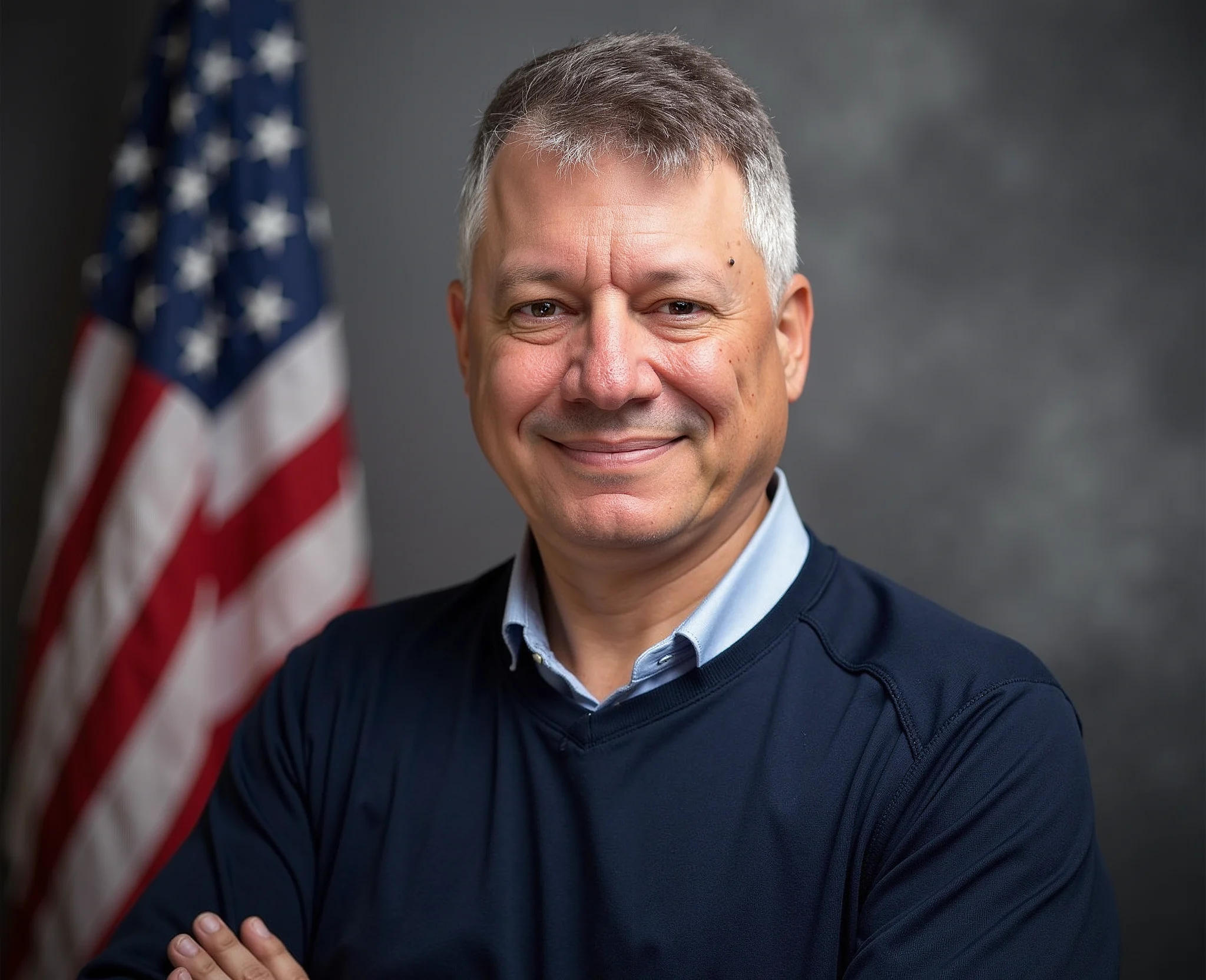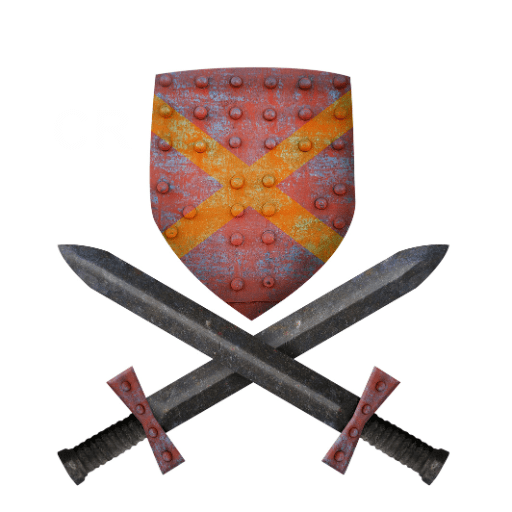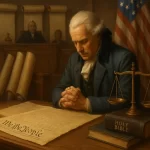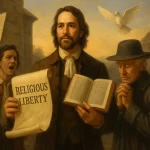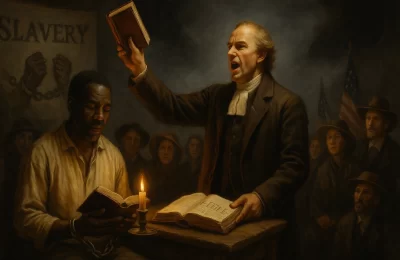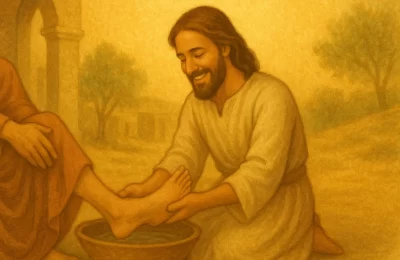Part 7 of Civic Theology: How the Bible Shaped America’s Founding and Freedom
Alexis de Tocqueville once observed that the typical American pioneer ventured into the wilderness armed not only with an ax and plow but with “a Bible, an ax, and some newspapers,” a telling image of faith and practical providence. Wherever those early settlers planted a cabin, they invariably planted the Word of God alongside it. Even Tocqueville marveled that the moving frontier carried Scripture in one hand and the tools of labor in the other, eager to tame the land spiritually as well as physically. In fact, Methodist leaders ensured that no new settlement went entirely without a preacher. Bishops appointed circuit riders to every “district or circuit wherever people were settling,” and these horse-preachers would take the Gospel into cabins, clearings, and camps before courthouses or schools had been erected . In the rough frontier days, itinerant pastors spent months traversing miles of trail, carrying saddlebags of hymnals and the Bible, preaching “every day at any place available” – including field schoolhouses, a settler’s cabin, even a makeshift courthouse or a barn . In consequence, the first public building in many a frontier town was the church or preaching hall – Sunday schools often met under brush-arbors or in the home church before clerk’s offices or jails. In short, the Gospel beat the government’s gavel and the schoolmaster’s desk onto the prairie.
This deep Christian character is captured by the imagery of Psalm 128:1–2: “Blessed is everyone who fears the Lord, who walks in his ways! …You shall eat the fruit of the labor of your hands; you shall be blessed.” That psalm could have been written for prairie families. Fathers and mothers rose at dawn to plow fields or build cabins, yet they rose first to call the household to prayer. They worked the land with one hand and held the hymnal or Bible in the other, trusting God’s promise that labor done in faith would indeed be “blessed” by Him. As they toiled, prayers went up over the new settlements, and on Sunday the whole community (if only a handful of families) gathered to listen, sing and worship. Even in an ax-heap tent revival, faithful voices raised “the Lord is risen, indeed!” around a hastily erected pulpit.
The First Priests of the Frontier
Churches and Sunday schools were not afterthoughts on the frontier – they were often community priorities. In the vast prairies and forests beyond the Alleghenies, the faithful built simple chapels of logs and puncheon floors even while clearing fields and digging outstumps. (In some places the first frame building completed was the parsonage – a home for the preacher!) Children learned their letters by copying Scripture. Grandmothers read the Bible at breakfast by lantern-light, and fathers led table devotions at supper. Evening hymn-singing around a lamp or even an open fire was commonplace. Even when a town had no minister or church, lay families still banded together for prayer meetings, turning a neighbor’s cabin into a Gospel “church” for a morning.
Methodist circuit riders and Baptist itinerants traveled these wilds systematically. As one historian noted, by the 1820s and 1830s the Methodist structure of “annual conferences” meant preachers were literally sent out wherever people settled . Bishop Francis Asbury and his successors kept the circuits well- supplied. By 1804 there were only 9,000 Methodist congregants and under 100 traveling preachers; by 1839, those numbers had mushroomed to 749,000 members with 3,557 circuit riders on the move . In other words, the church grew at prairie speed, a living vine spreading over the new towns. Even on the frontier, scripture and sermon were never far away: as the Wikipedia entry dryly notes, riding on horseback preachers would “conduct worship…in addition to possibly establishing new churches,” visiting cabins, courthouses, and fields on their rounds . One can almost picture the “log-cabin church” with outhouse and all – a single room with rough benches – filling up under the summer sun as folks sang classic hymns like “Jesus Loves Me” and listened to the preacher’s anointed Word.
A strong communal faith was reinforced by frontier laws and customs grounded in Christian ethics. Sunday ordinances, often called “blue laws,” were nearly universal. County courts and schools closed on the Sabbath. Frontier folk expected the day to be for worship and rest: even wandering buffalo hunters or fur traders felt the propriety of pausing work and attending a Sunday meeting whenever they could. Temperance societies also formed early. The frontier town might have rough-and-tumble elements, but many communities voted in strict liquor laws to protect women and children – in effect saying that the health of neighborly Christian virtue trumped Saturday night revelry. This was true community justice, tempered by the common faith: settlers adopted courts of “a few good men” who often invoked a higher righteousness. Judges and juries, almost all Christian themselves, did justice while exhibiting mercy. Only when wrongdoing was blatant did frontier courts deliver harsh sentences – but even then, ministers often lobbied for clemency and the offer of pardon or rehabilitation if the lawbreaker would repent. The ideal was clear: one was to “trust in the Lord with all your heart” (Proverbs 3:5–6), not only at home and church, but in the laws of the land. In essence, pioneers believed that even frontier law – like all life – should acknowledge God and walk in His ways.
Families of Faith on the Prairie
Out on the lonely frontier, home was church and school too. Around each cabin hearth sat families who lived out everyday faith. Before planting or hunting expeditions, fathers quoted scripture and invoked God’s blessing; mothers often taught little ones to “Fear the LORD and depart from evil” just as diligently as they taught them how to build a fire. Children learned hymns and verses by rote: one can imagine a family at the creek on a sweltering summer day, pausing at water’s edge, the older siblings (or parents) calling out a psalm as the little ones echoed the refrains. Soon that verse from Proverbs or one of David’s psalms (like Psalm 128’s blessing on the household of the godly) became as familiar to them as the sound of the wind in the pines or the creaking of their frontier wagon.
Nightly family devotions were routine. Even when the firelight flickered and the frontier winds rattled their crude shutters, a pioneer family would gather for Scripture reading and prayer. Mothers might pray for the crops, fathers for protection on the trail, and children for wisdom in the coming school day. Psalm 128’s promise – that a God-fearing man’s wife will be like a fruitful vine and children like olive shoots – was an everyday reality as those families did thrive in spite of hardship. They lived Matthew 28:19–20 without knowing it as a formal commission: baptized their children in the household faith and taught them “to observe all that [God] commanded” by word and example. They “trusted in the Lord with all their heart” (Prov. 3:5), acknowledging Him in every camping spot and crossroads – and indeed, they believed the Lord would “make straight their paths” .
And when they felt the weight of the wilderness and its unknowns, frontier Christians comforted each other with God’s promises. Through sickness or blizzard or lonely winter, they whispered, “The Lord is with you when you are with Him; if you seek Him, He will be found” (2 Chronicles 15:2). Mothers taught children to memorize entire chapters of the Bible (Mary Jones of later lore began as a mountain girl doing just that). Grandparents told stories of the Israelites in the wilderness – mapping their own Oregon Trail or Santa Fe journey onto Exodus’s portrayal of faith in the desert. Sunday evenings in frontier cabins often featured an open Bible on the table while everyone sang praises or listened to scripture; folk-whittled flutes might accompany spontaneous hymns until quiet settled.
Indeed, Hebrews 10:25 could have been coined out West: “Not neglecting to meet together, as is the habit of some, but encouraging one another…” Some older settlers taught newcomers the importance of communal faith – that even in sparsely populated territories, ten believers could shake the ground with praise in a timbered meeting house. Courtship among young people involved singing gospel duets by lantern light. Teenagers in one-room schools already sang “Old Hundredth” at afternoon prayers. In short, for these families the Word of God was the work of their hands. They literally believed David’s line, “You shall eat the fruit of the labor of your hands; you shall be blessed” (Psalm 128:2), because their day’s labor was wrapped in prayer and Psalm verses.
Camp Meetings and Frontier Revivals
When pioneers drifted, they often found each other in revival. The Second Great Awakening (1790–1840) hit the frontier with astounding force. Under blazing suns and starry skies, tens of thousands would gather at a chosen grove or clearing for camp meetings that lasted days. These were the “open-air churches” of the West: families arrived in wagons, slept in tents or wagons, cooked potluck meals, and took turns raising a little tent pulpit under which one preacher after another cried repentance and hope. As one source notes, camp meetings were “held for worship, preaching, and communion on the American frontier during the Second Great Awakening,” with worshipers traveling for miles to camp, pray, sing hymns, and listen to itinerant preachers at the makeshift tabernacle .
These gatherings were cinematic in scale and emotion. Itinerant revivalists like Peter Cartwright or Barton Stone – who knew rough living themselves – roused the crowd with plainspoken sermons, using frontier vernacular and humor even as they preached fiery grace. Saddlebag preachers, tired from weeks on the road, would set aside tobacco for the meeting and shout under the open sky that even the mighty Mississippi cannot quench the soul’s need for God. Campfires glowed around them; the songs of believers wove through the pines. The children of the frontier, in homespun dresses or pioneer buckskin, learned the same hymns (“All Hail the Power of Jesus’ Name,” “Amazing Grace,” “How Firm a Foundation” etc.) that echoed in city chapels. Even African American frontier families took part: freedmen’s camps after the Civil War often established their own camp meetings to exercise their new-found liberty in the Gospel. Wherever a tent revival was pitched – in a clear-cut Indiana field or the Flint Hills of Kansas – you saw every skin color standing as one before the preacher’s voice.
These revivals led many to formal church life. A Methodist camp meeting might spawn a new class or charge; Presbyterians or Baptists similarly pressed into the new nation planting mission churches. Baptized converts would then return to their settlements carrying small libraries of tracts and pocket Bibles, as it were, to shine light into the cabin window on the next night. It was common in such meetings that hundreds would “come forward” at once to be prayed for or baptized – an astonishing sight on the frontier. Justice and community ethics mingled here with mercy: if a former outlaw or drinker emerged crying for mercy at a revival, he’d often be embraced by the congregation with both stern admonition and warm forgiveness, exemplifying the biblical justice that “is merciful” in practice.
For all the enthusiasm, these gatherings retained the frontier’s down-to-earth ethos. Hymns and testimonies were often accompanied by fiddles and banjos from local musicians. When a river ran nearby, hesitant converts dunked themselves barefoot as in a primitive baptism. And at dusk, preachers like Charles Finney or Phoebe Palmer might look out over a crowd of settlers and declare that “no sin is too great and no backwoods hole too dark for the grace of God.” The Great Commission (Matthew 28:19–20) was thus fulfilled in microcosm: disciples were made of all (the frontier) nations – German, Scots-Irish, Yankee, Irish, Cherokee, African – baptized in the name of the triune God, taught to observe all Christ had commanded, from log chapels to tent revivals.
Gospel on the Move: Beyond the Barn Door
Even places without a formal church building showed the same pulse of faith. Along wagon trails a “brush arbor” might suffice for Sunday worship: four wooden posts, some bent saplings overhead, and a scattering of pews made by the menfolk. Pioneer evangelists would show a silent film of sorts in the settlers’ minds: they preached from Genesis to Revelation, never sure if one of the wagons was carrying the next William Booth or Harriet Tubman hungry for salvation. “Carry on, skedaddle preacher!” they might chuckle at long-expected sermons, but carried they did.
This frontier faith also softened legal strictness with grace. In many communities, even judges were lay church members who started court with a prayer. Summons could be postponed for family illnesses. When a drunk miner was caught stealing a Bible in Colorado, the judge (a Sunday School teacher himself) instead of jailing him, preached to him on the spot – the man walked out a week later as a repentant convert. Such mercy doled out by frontier justice bore the mark of Jesus’ teaching (Luke 6:36) more than the iron fist of Imperial Rome.
Meanwhile, lessons of Christianity flourished in freedmen’s camps and other minority communities. Even enslaved or recently freed African Americans on the frontier formed their own congregations and drew others by camp meeting and song (“Go Down, Moses” under a northern sky). These were meetings without an official church building at first, yet the content of their worship – communal prayer, testimony, singing – mirrored exactly the gatherings in any town across America. They too built Sunday schools on prairie sod, teaching themselves to read with the Bible as the primer. Freedmen’s help societies and early Black churches (on the frontier South or in western territories) incorporated temperance codes and morality clauses, attesting that Christian values had truly traveled West with the wagon wheels and the railroads.
All of this illustrates a simple truth: faith flourished even without grand temples. Beneath the cottonwood trees at a Texas Confederate camp (by legend), soldiers picked fights over who got the front seat in a makeshift “chapel.” Out of doors across the continent, Philippians 2:2 could have been their motto: they were “like-minded, having the same love, being of one accord.” Hebrews 10:25 was fulfilled over and over in little rough-hewn gatherings – “not forsaking the assembling of ourselves together” even when distance, weather, or poverty would have excused absence . In one story, a preacher when meeting an outlaw outside regular meetings said, “I can’t hide the Truth on a hilltop, brother – it’ll blow back on all of us.” So they met, wind in the belfryless barn, unscripted but spiritually scripted.
The Bible Blazes Westward
By the mid-1800s, vast tracts of land were dotted with churches – simple country Baptist or Methodist buildings, stone Presbyterian sanctuaries by highways, wooden Frontier Ontario houses that once held solely prayer. The cumulative effect of all those campfires and cabin lights: the soul of the frontier was shaped by Scripture. As Tocqueville observed of Americans’ piety, “the moral religion” was omnipresent in everyday life. We might paraphrase an old wilderness saying: “If a settler got lost in a forest and built a fork in the road, Scripture would furnish a fence at each fork and angels pointing each way.” Pioneer America treated the Bible as more than history or allegory – it was their chart and compass.
This heritage was not naive; it was by turns gritty and joyful. The tone of this age might have been sober in hardship, but it also sparkled with warmth and even wit. One old pioneer minister joked that if you ever doubted the power of faith, you should “go to a frontier revival and watch the crickets jump when the preacher hits high notes!” Another grandmother on the plains once tacked her hymn, “What a friend we have in Jesus,” right over the outhouse door – an amusing reminder that even the outhouse was sanctified by the spirit of prayer (and the hope of clean living).
Yet behind the humor lay an unshakeable conviction: that faith alone could tame the wildness of the West. Whether reading Proverbs by lamplight or singing Doxology by candlelight, those pioneers were asserting, day by day, verse by verse, that God was sovereign even over frontier valleys and mountain passes. Matthew 28’s marching orders – “Go therefore and make disciples of all nations” – had been taken seriously. The “all nations” in this case included Kerr, Duwamish, Sioux, and Shawnee as much as Boston Yankees and Southern Scots. Missionaries and ministers engaged Native Americans, taught freed slaves, and even conversed in frontier Spanish, Irish, and Creole to spread the Gospel.
The legacy of those early believers is profound. It reminds us that the Bible traveled westward with the pioneers and helped shape the soul of America. Hebrews 10:25 (“not forsaking our own assembling together”) is a timeless injunction; those frontier Christians took it literally, even when assembling meant three miles on horseback. Psalm 128:1-2’s blessing on the household is seen in every hearty frontier family portrait: farmwife with Bible in lap, husband behind plow, children chanting the Lord’s Prayer. Proverbs 3:5-6’s counsel to trust and acknowledge God was the frontier creed for pioneers embarking on river or prairie. And Matthew 28:19-20, the Great Commission, was the spiritual engine: setting year after year of young revivalists westbound, determined to teach the Savior’s commands in every new settlement.
In sum, the America Tocqueville found was not only a democracy, but a democracy of disciples. The pioneers’ America of Faith was rugged and prayerful. The image of the frontiersman with his Bible and his axe wasn’t a paradox; it was the essence of civic theology in motion: a people trusting Providence with a tool in one hand and God’s Word in the other. On those dusty trails and sunrises over plains, America’s future was prayed for and planned. The result was a frontier civilization where worship was as fundamental as work, where “the fear of the LORD” was more natural to people than fear of the law, and where hope was hammered out in anvil-and-hymn.
Indeed, the early 19th-century frontier was blessed, just as Scripture promised. By God’s grace, the wilderness roads were kept not just open, but holy. The highest priorities for those rough-hewn communities were God’s house, His Word, and His service. From Mississippi flatboats to Oregon wagons, the Word went west – illuminating the frontier nights and guiding the manifest destiny of a nation founded under God.
References
Tocqueville, A. de. (1835/2000). Democracy in America (H. C. Mansfield & D. Winthrop, Trans.). University of Chicago Press. (Original work published 1835)
Circuit rider (religious). (n.d.). Wikipedia. Retrieved April 24, 2025, from https://en.wikipedia.org/wiki/Circuit_rider_(religious)
Camp meeting. (n.d.). Wikipedia. Retrieved April 24, 2025, from https://en.wikipedia.org/wiki/Camp_meeting
Wyandotte County Biennial Report, 1878, First Biennial Report of Wyandotte County, Kansas (primary source).
Lewis, M. K. (Ed.). (1953). The journals of the Lewis and Clark expedition. University of Nebraska Press (originally 1804–1806)
Want to explore further?
Dig Deeper into Civic Theology
